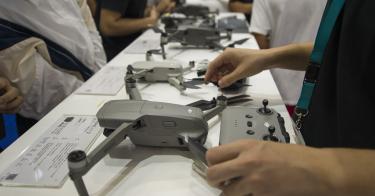Considering the obvious security threat posed by Chinese-made drones, you’d think banning federal agencies from buying or using them would be an easy lift for Congress. Not so, apparently.
In a surprising shift, the House and Senate removed a bipartisan effort to restrict such drones from the conference version of the FY2021 National Defense Authorization Act (NDAA) released last week. That’s right—they successfully thwarted their own best intentions.
Getting even the most clear-cut bill through Congress has always involved horse-trading as legislators move to bring more goodies to their respective states or districts. But one has to wonder which constituency gained from this move.
The danger China poses to all sectors of American society was reiterated last week by Director of National Intelligence John Ratcliffe. And the specific threat that Chinese-made drones bring has been driven home by independent studies, federal agencies, Congress and actual video footage from within China.
>>> The Nefarious Nature of Chinese Drones
Studies by two leading cybersecurity and research firms, Synacktiv and River Loop Security, reverse-engineered applications that allow users to control Chinese drones or edit videos they capture. They discovered the controller app had coding that enabled its Chinese developer to download and execute “other” code whenever it chose. Both applications collected sensitive user data and transmitted it to third-party servers without user consent.
Moving on those studies and their own well-founded concerns, the Departments of Defense, Interior and Homeland Security all either warned against or prohibited the procurement of Chinese-made drones. Until now, Congress appeared to be listening.
In early 2020, the Senate Homeland Security Committee passed The American Security Drone Act, prohibiting the federal government from buying or using Chinese drones with unanimous bipartisan support—including that of Sen. Kamala Harris(D-Calif.). Similar language was added to the House version of the NDAA.
But for mysterious reasons, that language was removed from the version of the NDAA that the House and Senate Armed services committees agreed on last week. Why?
It wasn’t fair trade. Eighty percent of all commercial drones sold in the United States are Chinese, while American manufacturers account for a paltry 8 percent of the market. When you combine the national security risks of Chinese drones with Chinese market dominance, one might think legislators that represent drone manufactures in California, Washington, Massachusetts, Florida and North Carolina would have been able to convince their colleagues to keep the drone language in the NDAA. But that didn’t happen.
So who won from this Chinese lobbying effort?
The revelations of those technological risks come at a particularly bad time for U.S.-China relations, which are already saddled with Beijing’s industrial espionage/stealing trade secrets, its masking of the COVID-19 outbreak and its abhorrent human rights violations.
In mid-July, shocking footage posted on Twitter showed a drone made by DJI, the world’s leading drone manufacturer, monitoring Chinese paramilitary police as they escorted shackled and blindfolded Uyghurs at a train station in Xinjiang in the fall of 2019.
>>> DJI Placed on the Entity List for Human Rights Abuses
The Chinese Communist Party (CCP) is a bad actor, and the fact that it successfully lobbied legislators to strip the drone text from the NDAA that the House passed this week and the Senate will vote on over the next few days will only encourage similar efforts. While there’s a small chance Congress could still separately pass the drone legislation, any action will likely shift to the executive branch.
Consider the Commerce Department’s “Entity List.” It’s comprised of foreign individuals and organizations that have been found to act in unscrupulous ways, and places them under severe export restrictions. Xinjiang Autonomous Region Public Security Department (XARPSD), the regional Chinese government that is suppressing the Uyghurs, was placed on the Entity List in October 2019. Adding those who aided the XARPSD in suppressing the Uyghurs, like DJI, would severely constrain their drone sales and operations in the U.S.
But time is growing short. In all likelihood, it is now up to President Trump to restrict the federal purchase and operation of Chinese drones and the threat they pose to America.
In the words of Director Ratcliffe, “the People’s Republic of China poses the greatest threat to America today, and the greatest threat to democracy and freedom worldwide since World War II.” It’s time we put that threat in check.
This piece originally appeared in The Hill on 12/10/20




